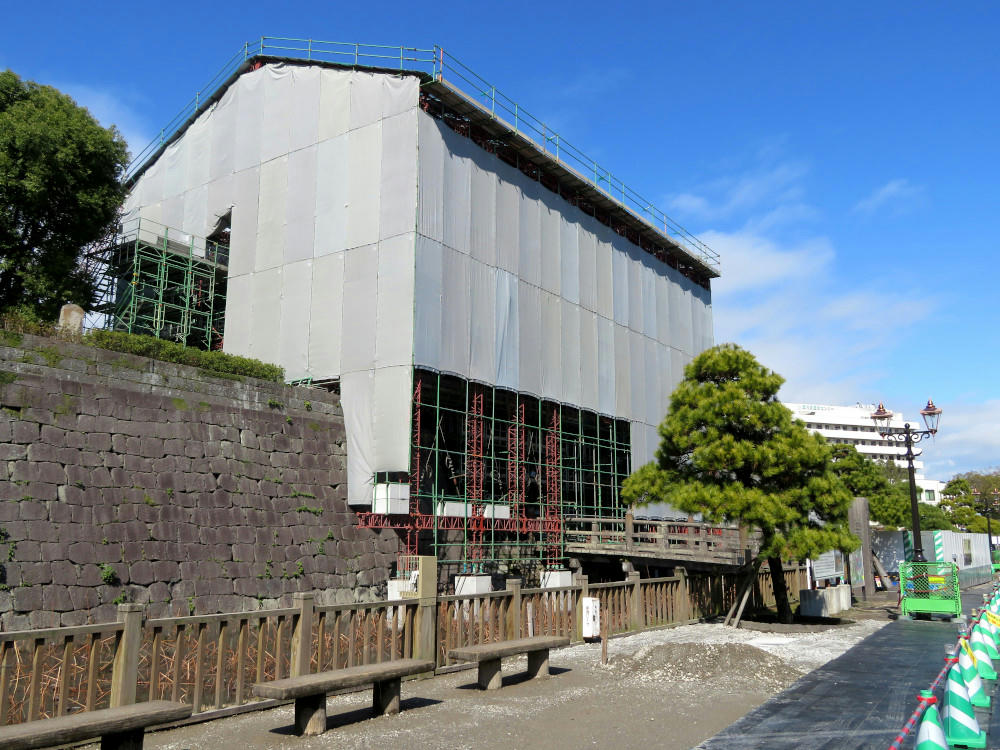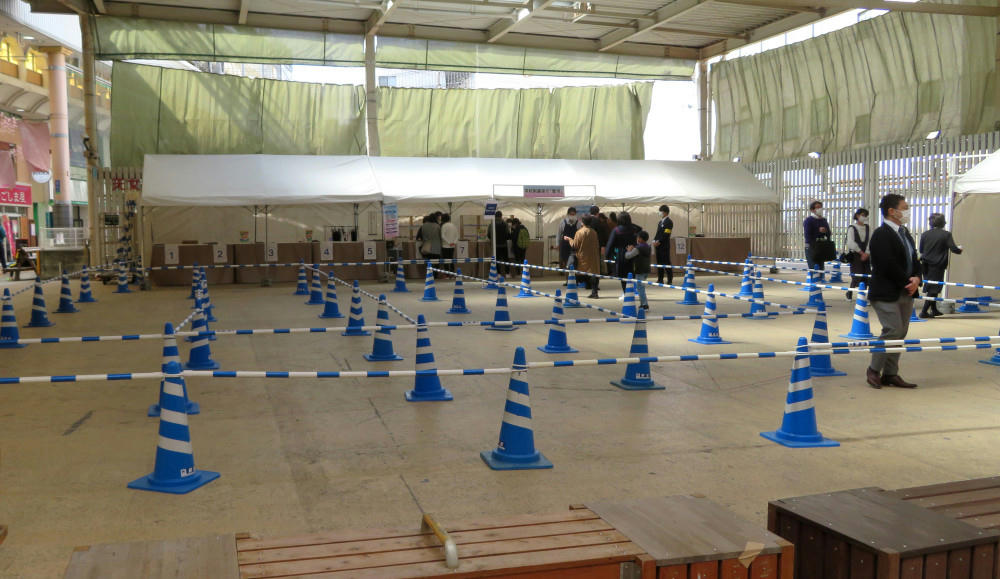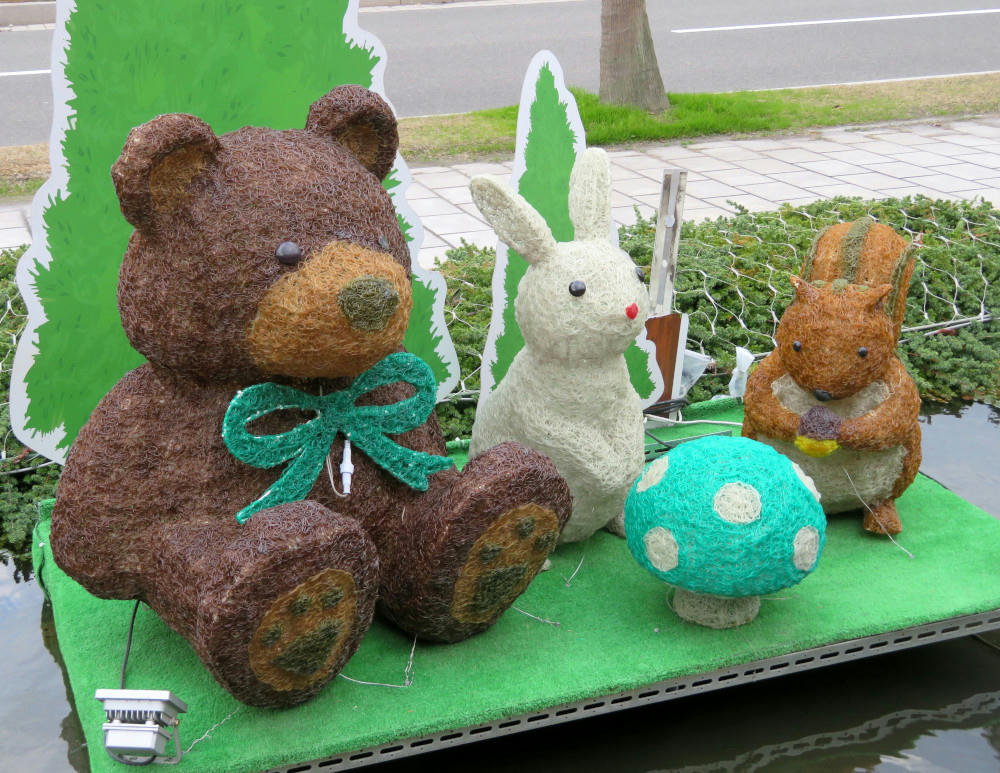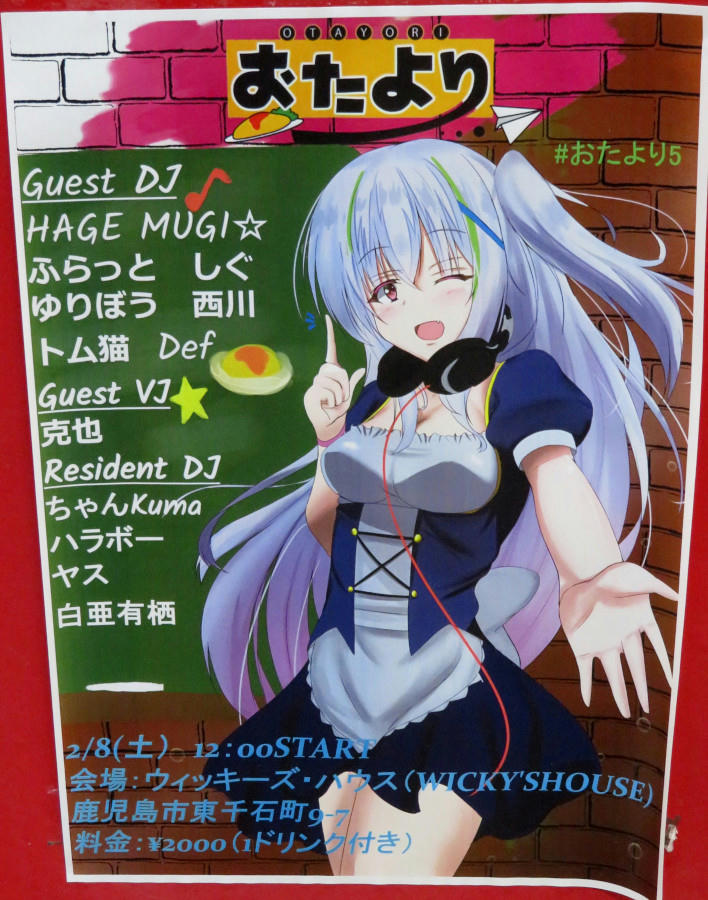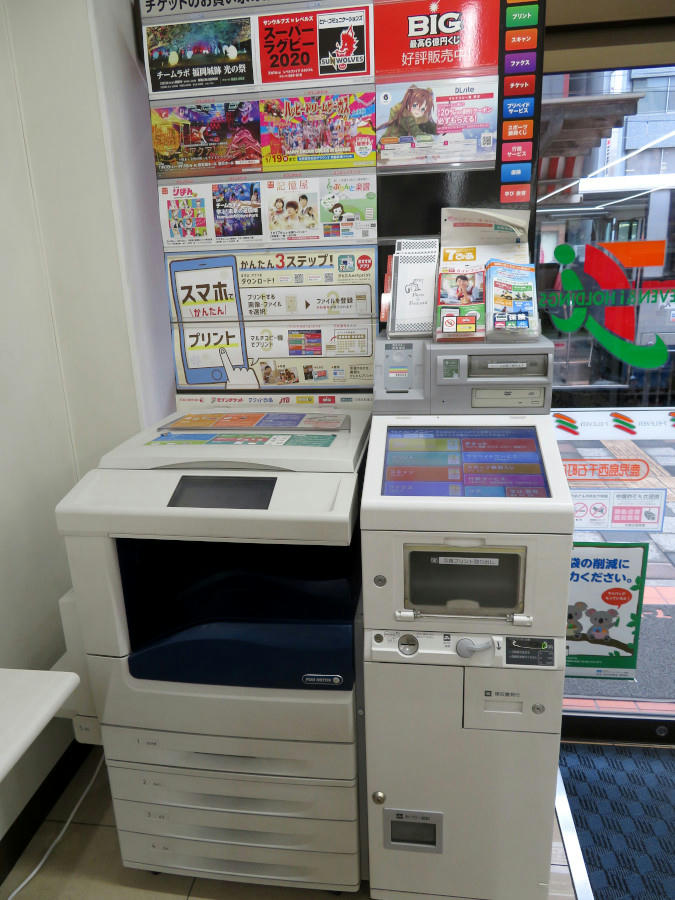(All rights belong to their owners.
Image from Amazon.co used here for review purposes only.)
Q.E.D. iff, vol. 15, by Katou Motohiro. Grade: B
This book came out at the same time as the latest C.M.B., and I did buy them together, but I loaned this one to one of my students, and I didn't get it back until just a couple of days ago. So, now here we are.
Sono Sekai (That World, Shonen Magajin R, 6, 2019)
Thirty years ago, overly strict and demanding patriarch and village leader Choujirou Reimei was beating the crap out of one of his sons, Touga. The dispute was over Touga's insistence on leaving Reimei village to seek out his fortune in Tokyo. When untied from his tree, Touga kept trying to crawl away, so Choujirou yelled at him to go ahead and never come back, adding that the trip down the mountainside in the winter would most likely kill him, if he wasn't eaten by bears first. Fast-forwarding to the present, new lawyer Chidori Kirishima is pleading for help from Kana and Touma. She's still really inexperienced, and her first serious job is to handle an estate case, where some mysterious stranger has instructed her to bring Touma along for the reading of the will.
The trio go to Reimei village, where things are mostly quiet. The kitchens at Choujirou's mansion are busy, though, with the return of the old man's heirs. They have the oldest son, Mansaku; the oldest daughter, Kyouko; the youngest son, Momohiko; and the youngest daughter, Rei. There's a lot of money involved, since the Reimei family has been linked to the main government since the Edo period (several hundred year's worth of history), and they own most of the land around the village. The estate has a high cliff, and a small lake, both with Shinto shrines. Choujirou and Mansaku are both Shinto practitioners, and Mansaku as the oldest living heir is expected to get everything. That night, there's a big dinner, and the four heirs complain about Chidori and her two compatriots being where they're not wanted. Toward the end of the evening, Mansaku is spotted wearing his white robes, outside by a tea garden house. The guests all go to the house, but Mansaku isn't there. Someone notices him outside the back of the tea house, strung by a rope upside down from a high tree branch. When he's lowered to the ground, Mansaku isn't breathing, and there's blood leaking from a knife wound in his chest. The police are called, and Det. Ameyama arrives on the scene. He's fairly competent, and he goes through the motions of having his men investigate the crime scene, and interrogating the witnesses. In a small creek in the garden near the tea house, they find a note with a mysterious marking - a dot-dash-dot pattern above what looks like a square letter "L". The main local priest pretends to not know what it means.
Kana and Chidori talk to the priest the next day, and he tells them that there are really only two direct heirs to the estate, Mansaku and Kyouko. Rei and Momohiko came from different mothers. Suddenly, the priest realizes that the symbols found by the body are somehow related to the long-missing son, Touga, who had his own shrine up on the cliff. Back at the tea house, Touma is walking in the hallway and looking at a copy of the symbols when he sees something near the baseboards of the back wall. Suddenly, people outside start yelling and running toward the lake shrine. When they get to the edge of what's really just a big pond with the shrine set up in the middle, they find Kyouko lying dead in the only rowboat on the estate. This is definitely a murder mystery, and a second note is found on the body, this one a straight line over a circle with a dot in the center. The police use an inflatable raft to get to the woman, who has rope marks around her neck. The second note seems to point more directly at Touga. However, Momohiko keeps playing word games with the cop interrogating him, which seems odd.
Kana and Chidori climb the path up the cliff to what had been more of a small cabin, but which is completely destroyed now. Inside are old math textbooks, and it becomes clear that Touga had fought with his father over a desire to go to a university in Tokyo to study for a math degree, when the old man had a "you live in this village, I own you" mindset. A plaque board that had been at the doorway of the cabin also has the symbols from the death notes, plus one more at the bottom - a smudgy "less-than" sign. Det. Ameyama decides to take on a quest to find this "Touga," who apparently had last been seen in Boston. In Boston, a university admissions clerk tells him that they did have a "Touga," but after graduation, he'd taken on a software engineering job in California. In Silicon Valley, Ameyama talks to Touga's former boss, who says that Touga had changed his name to Shigeru Yoshida, and had a daughter. When the daughter graduated from a nearby high school, the two of them left for her to go to university somewhere. Ameyama goes to the high school, and gets permission to look through the yearbooks, where he finds that Touga's daughter is actually Chidori Kirishima (in the yearbook, it's Chidori Yoshida). Back at the mansion, Rei is walking along the cliff and is attacked from behind. She is taken to a hospital, where she says she doesn't know what had happened to her. The note found near her has the "less-than" sign on it. Det. Ameyama orders Chidori arrested.
Kana tried to surprise Touma by telling him what they'd found at the cabin ruins, but the boy has already figured it out. Touga was enamored with math, and had modeled his "Shinto name" after Euclid's Axiom's. The "dot-dash-dot" part is the straight line connecting two points. The square "L" was the right-angle. The other straight line referred to parallel lines not meeting, and the circle with a dot in the middle was "a line drawn around a fixed point creates a circle." The "less-than" sign is really a reference to the "parallel postulate." Everything is pointing to Chidori as wanting revenge on her grandfather's family, and killing them all off to get the inheritance. But, Kana thinks she's innocent and wants Touma to prove it.
Questions: Is Chidori innocent, or is she playing Kana? If innocent, then who is the real killer, how did they commit the murders, and what do the symbols left by the bodies really mean?
Math: The discussion of Euclid's Axioms, and how they tie in with the story plot.
----- Spoilers -----
The killer made a mistake. The symbol found on the plaque board at the ruined cabin was smudged up. The last symbol really should have been a closed triangle, since the postulate is "if a straight line falling on two straight lines makes the interior angles on the same side less than two right angles, the two straight lines, if produced indefinitely, meet on that side on which the angles are less than two right angles." That is, the three lines make a triangle. The killer apparently didn't do quite enough homework. Anyway, they slipped up regarding Mansaku's Shinto vestments as well, dressing the body in the wrong clothes before tying it up behind the tea house. The trick was performed with a pinhole camera effect. There's a hole in the baseboard of the back wall of the tea house that's fitted with a glass lens. The killer put a bright light on a small piece of wood and floated it on the creek between the tea house and the tree. After some time, the light reached the body, where it was reflected to the lens in the wall, and projected right-side up on the front paper screen of the tea house, making it look like Mansaku was standing at the house entrance before turning and moving away. Hence, the "two points, straight line" clue.
For Kyouko, the killer had a rope with one end tied to a tree at the far end of the lake, submerged under the surface of the water, running up to the roof of the shrine structure, and then looped under the water to the near shore. When Kyouko got to the shrine in the boat, the killer grabbed the end of the rope near him and yanked on it, causing the loop to leap from the water and tighten around the woman's neck. With Rei, the "less-than" sign implied an accident on a hillside, which she survived. And, all of the clues pointed to Chidori in order to cut off the last of Touga's line, leaving the killer as the only one that was still standing. But, along with the misunderstanding of the last postulate, and a few other slips regarding Masaku's Shinto outfit, the real killer is revealed to be Momohiko, who had inherited his father's mean streak. At the end, after Momohiko is led away, Touma comments on how he'd met Touga at MIT when they were both in Boston, which is why he'd been brought in to keep a protective eye on Chidori. There's a male silhouette standing at the front gate of the estate, and the young woman is instructed to go invite her father inside.
Hito ga Mada Mirukoto ga Dekinai (I Still Haven't Seen People, Shonen Magajin R, 1-2, 2020)
It's the future again, and Kana is a young lawyer handling robot attacks cases again. The attacks are minor, and in some cases, it's just a matter of service robots (i.e. - a dog-walking robot) that seem to be dropping things or breaking their programming. One robot is dressed up as a maid in front of a goods shop in Akihabara. It gets sexually harassed by a greasy otaku, and it suddenly attempts to kill the guy. The owner has to smash it in the back of the head with a bat to save his customer. There are 200 pending complaints against a specific development company, so Kana starts following up on some leads. Pretty quickly, she runs into Touma, who is playing his part as a genius software developer who knows her only from the last story about the gimmicked court AI. Some company is claiming that their cleaning robot went rogue and smashed through a plate glass door, and they want the insurance money. In fact, one of the employees had deliberately broken the glass with their shoulder and propped the robot on the shards to frame it.
The next case is the dog-walking robot, which indeed veers off its programmed route to stop at the middle of a bridge to stare at the river below for a while with its camera eye. Touma asks the owner for the robot, and he goes back to his houseboat under the expressways in Tokyo to take it apart. He finds a wireless chip tacked onto the main motherboard. He then goes to the manufacturers - Fero Inc. - to find out what they know. There are three people at the table, an older woman and two men. The woman seems to be a spokesperson (or the CEO), and one of the guys is a corporate lawyer. Initially they try to evade the questions, but Touma knows too much. Eventually, they state that there was this really brilliant AI programmer who was highly unstable. He's not at the company anymore, but he's the reason for all their problems. The lawyer reveals the guy's name as Dr. Alrushe. Touma and Kana go to Fero's R&D labs and find Alrushe's office cluttered and abandoned. On one shelf is a photo of a beautiful singer, and on a bench are the internals of a large cleaning robot. Some guy sneaks into the room, and asks if they're looking for his partner. This new guy is Luis, and he'd been working with Alrushe for a while. They go to a coffee shop, and Luis says that Alrushe had been working on an AI problem, and it had left him a nervous wreck. Eventually, he'd claimed that he was near a breakthrough, but at about that point, Luis spotted someone who looked like an assassin going to the office, and then coming back out. Luis never saw Alrushe after that. A little later, the corporate lawyer gets a text message demanding $300,000 in return for a missing robot.
Touma is standing out at a railing in a deserted park, and the same assassin-looking guy comes up behind him to shoot him with a silencer. Kana drops from the tree above and quickly subdues the killer. Touma and Kana bring the guy to the houseboat for interrogation. He says that, yes, he'd been sent to kill Alrushe, but the researcher wasn't in his office at the time. He has a jacket camera disguised as a frog broach on his lapel for documenting his contracts, and it proves that he's telling the truth. He tells Touma what he knows, and is then handed over to the police.
Questions: So, what is going on? How does all of this tie together? Where is Alrushe, how did he avoid death, and why did he put the wifi chip on the dog-walker robot?
Science: Just some speculation on the future of AI, and a riff on Asimov's Three Laws.
----- Spoilers -----
Touma reassembles the walker robot and addresses the video camera, saying that he knows what's going on and wants to talk to the person at the other end of the connection. He asks, "What's your name?" and the robot pauses before answering "Galatea." (Galatea is the name assigned to "the statue carved of ivory by Pygmalion of Cyprus, which then came to life in Greek mythology" (from the wiki article). Touma and Kana are granted permission to meet Alrushe. Basically, the researcher had been working on perfecting a self-aware AI. He'd added wifi chips to various Fero Inc. robots in an attempt to increase the amount of interaction Galatea received with the real world, but the leaders of Fero found out. They wanted to keep the secret for themselves, and hired a contract killer to snuff the researcher. However, he'd hid himself in the case of one of the cleaning robots, and snuck away unseen along with the server box containing the Galatea program.
Some distance away, at a remote house at the top of a cliff overlooking the ocean, Touma and Kana meet Alrushe. Our hero lays out what he suspects, and the other guy tries to laugh it off. But, Galatea tells him "thank you" for all he's done, and a picture of a beautiful woman is superimposed over the hardware case. A little later, Touma, Kana and Alrushe are in a judge's office along with the Fero woman and the lawyer. The case being argued before the judge is "who owns Galatea." Alrushe has a copy of the original code, which the judge orders to be given to Fero, which makes the woman and the lawyer absolutely ecstatic. But, the caveat is that 5% of anything they make on sales related to the software goes to Alrushe for the next 10 years (they're not so happy about that). So far, things seem to be going smoothly, until Touma explains why Fero Inc. really wants Galatea. The idea is that the software has gone fully self-aware, making it more-or-less on par with humans. So, what happens if you just shut it off? Fero's ultimate goal is to learn what lies after death by "killing" Galatea over and over again, hunderds, if not thousands of times. Which is something you can't legally do to flesh-and-blood people.
Horrified, Alrushe grabs the only currently working Galatea server and prepares to smash it to the ground to prevent the worst case scenario from happening. The judge rules Galatea sentient, and any attempt to shut it off or destroy the disks is tantamount to murder. He tasks the responsibility for ensure the AI's well-being to Kana, and Touma volunteers to help. The chapter ends with a male chef robot cooking meals in the kitchen of a small monastery somewhere near a coastline. A monk praises the robot's great work, but he has to ask if it's really happy here. There's a mostly-blocked image of the server sitting on a small table nearby, as the robot says "Yes, I can see the sea from here."
Summary: "Sono Sekai" is kind of a contrived murder mystery, and there's no really good reason for the tricks to have been so difficult for anyone else other than Touma to figure out. Specifically, the killer did everything to frame Chidori, when no one else in the family even knew she existed. Yes, the finger of suspicion could have been pointed to Touga, but as far as anyone else knew, he'd been eaten by bears 30 years ago. And, I do take umbrage at Motohiro's romanticization of humanoid robots and AI. That, and there's no way that the first working implementations of self-aware systems would fit in a half-sized tower box. But, this is fiction, so anything can be possible in this universe. Regardless, the stories are ok, and I liked seeing a return to a math-based story after such a long drought. Recommended if you like the series.

